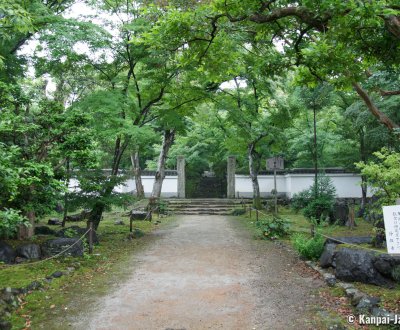Joju-ji
Maple Foliage in the West of Kyoto
Joju-ji is a Buddhist temple located in the quiet Rakusai neighborhood in Nishikyo ward, western Kyoto. The tall Japanese maple trees surrounding the spiritual compound freshen up the air in summer thanks to their young green leaves that seem to be set ablaze in autumn for the contemplation of their vibrant koyo.
Joju-ji’s grounds is next to the Jizo-in bamboo temple and benefits from the same quiet Zen atmosphere, with trees concealing the Buddhist pavilions under a thick vegetal cover. The place is protected from the city’s hustle and bustle and from tourists alike, as most of them don’t take the exploration of Kyoto this far.
Small Zen temple of Chinese inspiration
Founded in 810 on the request of the Emperor Saga (786 - 842) by monk Ennin, better known under his posthumous name Jikaku Daishi (794 - 864), Joju-ji was first a temple of the Tendai School. It later thrived as the spiritual site of the Hamuro family, which is also the name of the mountain at the foot of which it was built (Hamuro-yama). The temple now belongs to the Obaku sect, a branch of Japan’s Zen Buddhism with close ties to China and less famous than the Soto and Rinzai schools. Its buildings retain Chinese influences, such as the facade of the Hondo main hall (reconstructed in 1697) displaying a circular window.
The Hojo hall is a former samurai residence with connection to the Date clan. The 4th lord of the Sendai domain, Date Tsunamura (1659 - 1719), spent his childhood in this manor house before it was relocated in Kyoto. From this troubled historical times remain a mechanism hidden in the walls, called Samurai Hidden, that allowed a discreet escape from the building.
The pavilions face a little Japanese garden dating back to the Edo period (1603 - 1868) with a pond at its center. The main Buddha representation worshiped here is Nyoirin Kannon, or Nyoirin Kanzeon Bosatsu.

Fall koyo spot near Arashiyama
Joju-ji is in Rakusai, a neighborhood located in the west of Kyoto’s downtown and to the south of Arashiyama. Overlooked by forestry mountains, the landscape in Rakusai is green and rural, especially thanks to Oharano, an agricultural area. While it is less frequented by tourists, the vicinity is nonetheless home to interesting temples and shrines such as: Saiho-ji, Suzumushi-dera, Matsuo Taisha and Katsura Imperial Villa.
The entrance to Joju-ji is as the end of a quiet residential street, and marked by a majestic and authentic stone stairway surrounded by maple trees. From spring 🌸 to the beginning of summer, the tender green leaves (aomomiji) preserve the coolness. One must wait until autumn, at the end of November, to admire the beautiful approach of the temple, when the maple tree’s koyo foliage turns into a flamboyant red. During this ephemeral season, Joju-ji becomes a secret spot for contemplating the momiji 🍁. At this time of the year, a special visit including a tour inside the Hondo and Hojo pavilions is also organized.

